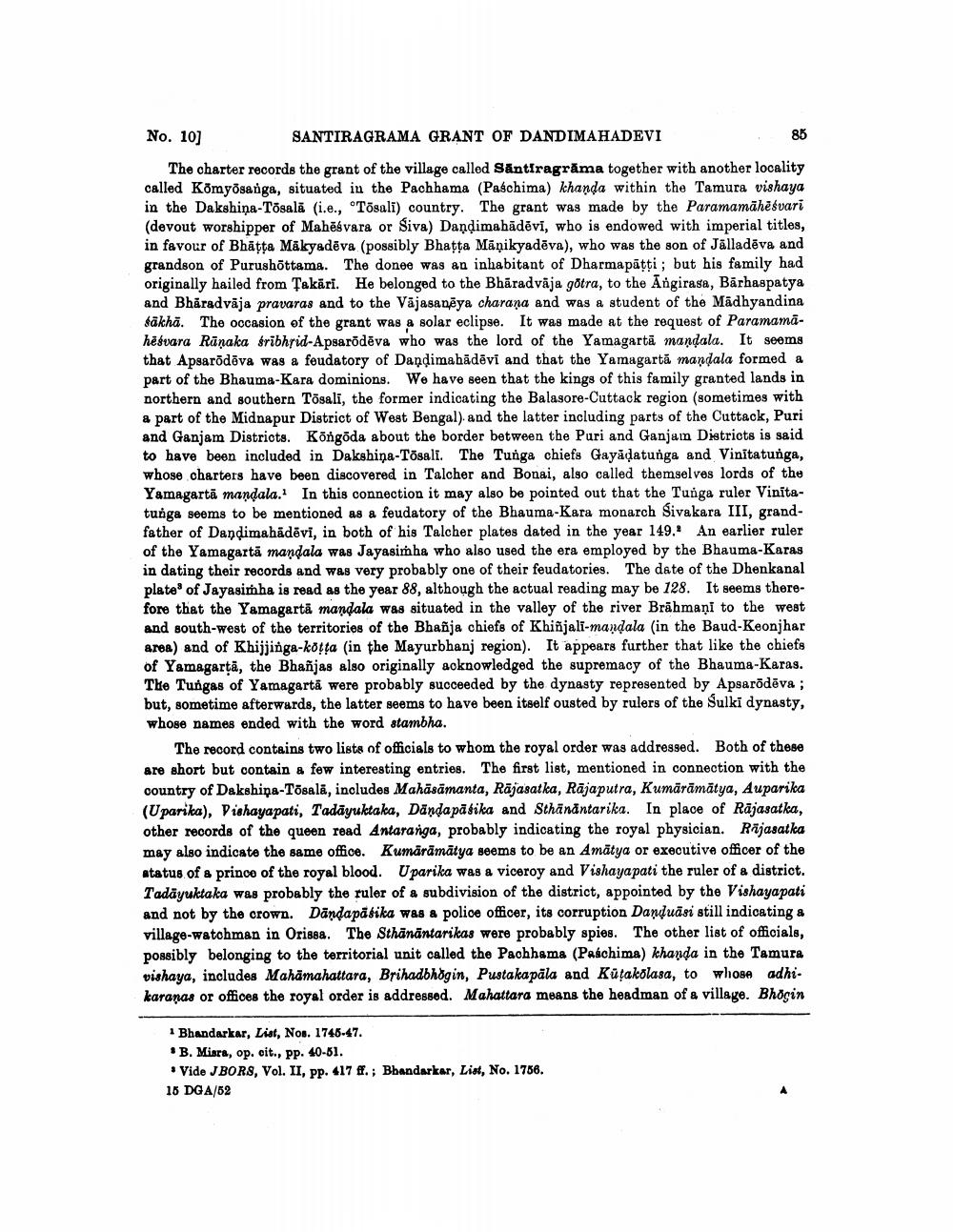________________
No. 10)
SANTIRAGRAMA GRANT OF DANDIMAHADEVI
85
The charter records the grant of the village called Santiragrăma together with another locality called Kömyösanga, situated in the Pachhama (Paschima) khanda within the Tamura vishaya in the Dakshina-Tõsalā (i.e., Tösali) country. The grant was made by the Paramamähesvari (devout worshipper of Mahē vara or Siva) Dandimahādēvi, who is endowed with imperial titles, in favour of Bhatta Mäkyadēva (possibly Bhatta Māņikyadēva), who was the son of Jalladēva and grandson of Purushottama. The donee was an inhabitant of Dharmapätti; but his family had originally hailed from Takäri. He belonged to the Bhāradvāja götra, to the Angirasa, Bärhaspatya and Bhäradvāja pravaras and to the VājasanĒya charana and was a student of the Mädhyandina sākha. The occasion of the grant was a solar eclipse. It was made at the request of Paramamaheśvara Rānaka sribhrid-Apsarõdēva who was the lord of the Yamagartā mandala. It seems that Apsarõdēva was a feudatory of Dandimahādēvi and that the Yamagartă mandala formed a part of the Bhauma-Kara dominions. We have seen that the kings of this family granted lands in northern and southern Tösali, the former indicating the Balasore-Cuttack region (sometimes with a part of the Midnapur District of West Bengal). and the latter including parts of the Cuttack, Puri and Ganjam Districts. Köngöda about the border between the Puri and Ganjam Districts is said to have been included in Dakshina-Tõsali. The Tunga chiefs Gayadatunga and Vinitatunga, whose charters have been discovered in Talcher and Bonai, also called themselves lords of the Yamagarta mandala. In this connection it may also be pointed out that the Tunga ruler Vinitatunga seems to be mentioned as a feudatory of the Bhauma-Kara monarch Sivakara III, grandfather of Dandimahädēvi, in both of his Talcher plates dated in the year 149. An earlier ruler of the Yamagartă mandala was Jayasimha who also used the era employed by the Bhauma-Karas in dating their records and was very probably one of their feudatories. The date of the Dhenkanal plate of Jayasimha is read as the year 88, although the actual reading may be 128. It seems therefore that the Yamagarta mandala was situated in the valley of the river Brähmani to the west and south-west of the territories of the Bhañja chiefs of Khisljali-mandala (in the Baud-Keonjhar area) and of Khijjinga-kofta (in the Mayurbhanj region). It appears further that like the chiefs of Yamagartā, the Bhañjas also originally acknowledged the supremacy of the Bhauma-Karas. The Tungas of Yamagartã were probably succeeded by the dynasty represented by Apsarõdēva ; but, sometime afterwards, the latter seems to have been itself ousted by rulers of the Sulki dynasty, whose names ended with the word stambha.
The record contains two lists of officials to whom the royal order was addressed. Both of these are short but contain a few interesting entries. The first list, mentioned in connection with the country of Dakshina-Tõsalā, includes Mahāsāmanta, Rājasatka, Rājaputra, Kumārāmātya, Auparika (Uparika), Dishayapati, Tadãyuktaka, Dāndapātika and Sthändntarika. In place of Rajasatka, other records of the queen read Antaranga, probably indicating the royal physician. Rājasatka may also indicate the same office. Kumārāmātya seems to be an Amatya or executive officer of the status of a prince of the royal blood. Uparika was a viceroy and Vishayapati the ruler of a district. Tadāyuktaka was probably the ruler of a subdivision of the district, appointed by the Vishayapati and not by the crown. Dändapatika was a police officer, its corruption Danduāsi still indicating & village-watohman in Orissa. The Sthanāntarikas were probably spies. The other list of officials, possibly belonging to the territorial unit called the Pachhama (Paschima) khanda in the Tamura vishaya, includes Mahamahattara, Brihadbhogin, Pustaka päla and Kütakolasa, to whose adhikaranas or offices the royal order is addressed. Mahattara means the headman of a village. Bhögin
Bhandarkar, List, Nos. 1746-47. • B. Misra, op. oit., pp. 40-61. • Vide J BORS, Vol. II, pp. 417 ff. ; Bhandarkar, List, No. 1756. 18 DGA/62




